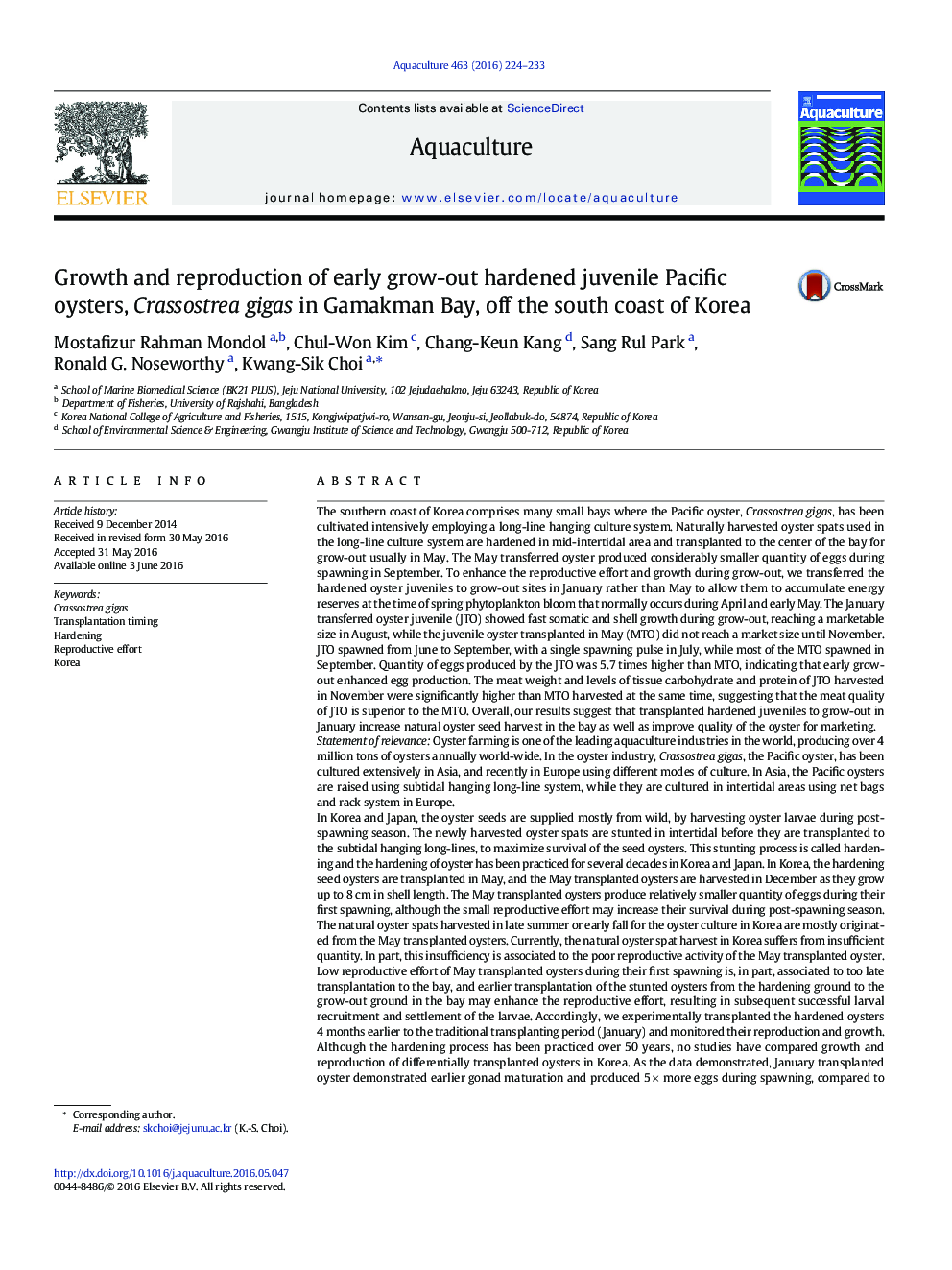| کد مقاله | کد نشریه | سال انتشار | مقاله انگلیسی | نسخه تمام متن |
|---|---|---|---|---|
| 2421358 | 1552824 | 2016 | 10 صفحه PDF | دانلود رایگان |

• We first compared growth and reproduction of hardened juvenile Pacific oyster differently transplanted in the bay in January and May.
• January transplantation provides a better scope to the oyster for utilization of energy in association with the spring phytoplankton bloom.
• Quantity of eggs produced by January transplanted oyster during spawning was 5.7 times higher than the traditional one.
• Grow-out transplantation before the spring could improve the spat recruitment as well as the oyster production in the bay.
The southern coast of Korea comprises many small bays where the Pacific oyster, Crassostrea gigas, has been cultivated intensively employing a long-line hanging culture system. Naturally harvested oyster spats used in the long-line culture system are hardened in mid-intertidal area and transplanted to the center of the bay for grow-out usually in May. The May transferred oyster produced considerably smaller quantity of eggs during spawning in September. To enhance the reproductive effort and growth during grow-out, we transferred the hardened oyster juveniles to grow-out sites in January rather than May to allow them to accumulate energy reserves at the time of spring phytoplankton bloom that normally occurs during April and early May. The January transferred oyster juvenile (JTO) showed fast somatic and shell growth during grow-out, reaching a marketable size in August, while the juvenile oyster transplanted in May (MTO) did not reach a market size until November. JTO spawned from June to September, with a single spawning pulse in July, while most of the MTO spawned in September. Quantity of eggs produced by the JTO was 5.7 times higher than MTO, indicating that early grow-out enhanced egg production. The meat weight and levels of tissue carbohydrate and protein of JTO harvested in November were significantly higher than MTO harvested at the same time, suggesting that the meat quality of JTO is superior to the MTO. Overall, our results suggest that transplanted hardened juveniles to grow-out in January increase natural oyster seed harvest in the bay as well as improve quality of the oyster for marketing.Statement of relevanceOyster farming is one of the leading aquaculture industries in the world, producing over 4 million tons of oysters annually world-wide. In the oyster industry, Crassostrea gigas, the Pacific oyster, has been cultured extensively in Asia, and recently in Europe using different modes of culture. In Asia, the Pacific oysters are raised using subtidal hanging long-line system, while they are cultured in intertidal areas using net bags and rack system in Europe.In Korea and Japan, the oyster seeds are supplied mostly from wild, by harvesting oyster larvae during post-spawning season. The newly harvested oyster spats are stunted in intertidal before they are transplanted to the subtidal hanging long-lines, to maximize survival of the seed oysters. This stunting process is called hardening and the hardening of oyster has been practiced for several decades in Korea and Japan. In Korea, the hardening seed oysters are transplanted in May, and the May transplanted oysters are harvested in December as they grow up to 8 cm in shell length. The May transplanted oysters produce relatively smaller quantity of eggs during their first spawning, although the small reproductive effort may increase their survival during post-spawning season. The natural oyster spats harvested in late summer or early fall for the oyster culture in Korea are mostly originated from the May transplanted oysters. Currently, the natural oyster spat harvest in Korea suffers from insufficient quantity. In part, this insufficiency is associated to the poor reproductive activity of the May transplanted oyster.Low reproductive effort of May transplanted oysters during their first spawning is, in part, associated to too late transplantation to the bay, and earlier transplantation of the stunted oysters from the hardening ground to the grow-out ground in the bay may enhance the reproductive effort, resulting in subsequent successful larval recruitment and settlement of the larvae. Accordingly, we experimentally transplanted the hardened oysters 4 months earlier to the traditional transplanting period (January) and monitored their reproduction and growth. Although the hardening process has been practiced over 50 years, no studies have compared growth and reproduction of differentially transplanted oysters in Korea. As the data demonstrated, January transplanted oyster demonstrated earlier gonad maturation and produced 5 × more eggs during spawning, compared to May transplanted oysters. No severe mortality was observed from the early transplanted oysters during the course of study, although reproductive activity of January transplanted oysters was relatively intensive, compared to May transplanted oysters.The present study first attempted to evaluate effectiveness of transplantation timing of the hardened oysters, in terms of growth and reproduction. Also, quantity of the eggs produced from differentially transplanted female oysters was first measured and compared in this study using ELISA. As the data indicated, January transplanted oyster produced 5 × more eggs, which may enhance the natural oyster spat harvest in the bay, as well as to evaluate the transplantation period and management of oyster farming on the south coast of Korea.
Journal: Aquaculture - Volume 463, 1 October 2016, Pages 224–233